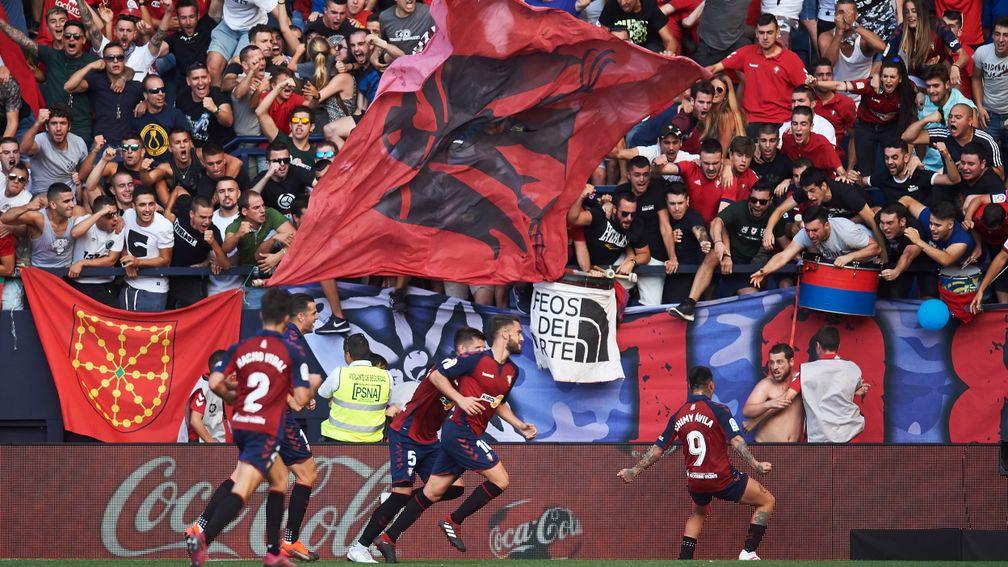Kevin Pullein: Back a low card count in Sunday La Liga clash
Football tips, stats and philosophy

Best bet
Under six Asian total cards in Osasuna v Levante
1pt 1.825 bet365
A low card count may be more likely than bet365 anticipate in Sunday’s early La Liga game between Osasuna and Levante.
Back under six Asian total cards at decimal odds of 1.825, similar to fractional odds of 5-6. Each yellow will count as one and each red as two. If the total is lower than six the bet will win, if the total is six stakes will be refunded and if the total is higher than six the bet will lose.
The number of cards likely to be shown in a match varies with how close it is likely to be. Evenly balanced contests tend to provoke more cards.
And Osasuna v Levante is likely to be fairly close. Odds in the result-related market, which seem reasonable, imply a 42 per cent chance of a home win, a 29 per cent chance of a draw and a 29 per cent chance of an away win.
My analysis of cards in La Liga in recent seasons suggests to me that in similar games fair odds about under six Asian total cards would normally be in the region of 1.625.
Referee Mario Melero Lopez showed high numbers of cards more often than most of his colleagues last season, and in some previous seasons. He might do so again this season. We should make an allowance for the possibility that he will.
But last season Levante featured in low-card games more often than usual for a team with their win/draw/loss record. They might not do so again this season. As a rule of thumb, abnormal stats tend to become less abnormal as time goes by. But we should make some allowance too for the possibility of a repeat from Levante.
Any card total is feasible, including many an unwanted one, but there do appear to be grounds for thinking the chance of a low tally could be more likely than bet365 envisage.
Thought for the week
Academics Ian McHale and Lukasz Szczepanski wrote a paper about identifying footballers’ goalscoring ability. It was published in the Journal of the Royal Statistical Society in 2014.
They wrote: “When it comes to analysing individual performance, one crucial thing to realise is that, as a football club, it is the future and not historical performance (in terms of goals or any other statistic) that a club is paying for in transfer fees and/or wages.”
They found that shot-conversion rate last season was less reliable than total shots last season as a guide to how many goals a player would score next season.
They concluded: “These findings should be of use in the transfer market, as they suggest that players should be recruited more on the basis of the number of shots they generate and less on the number of goals they score.”
Michael J Mauboussin wrote in a book called The Success Equation that a useful statistic has persistence. This means that “what happens in the present is similar to what happened in the past.” A footballer’s shot-conversion rate can vary a lot from one season to another.
A bettor in one sense is like a director of football. Success or failure depends not on what happened before but on what happens next. This makes it harder for them to use statistics well. Statistics record what has happened already.
Anyone whose fate depends on the future should want to know how well a statistic predicts what they are trying to achieve, and how closely, if at all, the statistic is likely to be replicated.
Today's top sports betting stories
Follow us on Twitter @racingpostsport
Like us on Facebook RacingPostSport
Published on 25 September 2020inFootball tips
Last updated 16:46, 25 September 2020
- Football accumulator tips for Saturday April 27: Back our 11-1 acca plus get £40 in free bets with Betfred
- Chelsea Women vs Barcelona Women prediction, betting odds and tips
- Hull vs Ipswich prediction, betting odds and tips
- Derby vs Carlisle prediction, betting odds and tips
- Colchester vs Crewe prediction, betting odds and tips
- Football accumulator tips for Saturday April 27: Back our 11-1 acca plus get £40 in free bets with Betfred
- Chelsea Women vs Barcelona Women prediction, betting odds and tips
- Hull vs Ipswich prediction, betting odds and tips
- Derby vs Carlisle prediction, betting odds and tips
- Colchester vs Crewe prediction, betting odds and tips